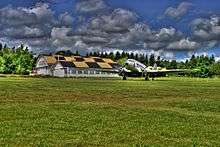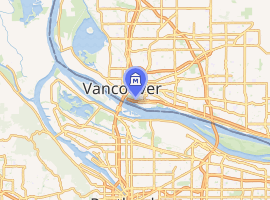Pearson Air Museum
The Pearson Air Museum is a place-based aviation museum at Pearson Field in Vancouver, Washington, USA. Managed by the National Park Service as part of the Fort Vancouver National Historic Site, museum exhibits provide an opportunity for visitors to explore aviation history tied to Pearson Field and Vancouver Barracks. Objects and artifacts from the National Park Service collections and on loan from members of the community and other museums depict history of aviation in the Pacific Northwest.[1][2][3][4] Admission is free.
 Pearson Air Museum | |

| |
| Location | 1115 E 5th Street, Vancouver, WA 98661 |
|---|---|
| Coordinates | 45.620°N 122.657°W |
| Type | Aviation museum |
| Website | Pearson Air Museum |
Exhibits
Pearson Air Museum is dedicated to telling the expansive history of Pearson Field, one of the oldest continuously operating airfields in the nation. Using exhibit panels along the wall, combined with large wall murals and aircraft, the museum is set up as a self-service exhibit that tells a chronological history of Pearson Field.
The exhibits start with the earliest development of aviation around the world, quickly tying it to the aviation feats that occurred directly at this location, much of which occurred before the formal origin of Pearson Field. This includes the 1905 flight of the dirigible, "Gelatine," piloted from the Lewis & Clark Centennial Exposition grounds in northwest Portland, Oregon, to the parade grounds of the Vancouver Barracks by Lincoln Beachey. This was followed in the 1911-1913 period by a succession of early fixed wing flights in home-built aircraft (such as an early Bleriot and Curtiss Pushers), by such early aviators as: Silas Christofferson and Charles Walsh. The museum interprets these early flights with exhibit panels, murals, and a recently completed full scale replica of Silas Christofferson's 1912 Curtiss Pusher. This replica was constructed using the materials, specifications and methods used in constructing the original, and is as close of an approximation of Christofferson's aircraft as could be made.
The "Straight-Grained Soldiers" exhibit includes interpretive panels, displays of artifacts, a large diorama, and participatory elements tied to the aviation history of World War I in the Pacific Northwest. As military aviation transformed methods of warfare during the First World War, spruce lumber to build combat, reconnaissance, and training airplanes was in high demand. The Pacific Northwest was home to one of the world's best supplies of spruce, and so the U.S. Military created the Spruce Production Division, headquartered at Vancouver Barracks, to ensure that the allies would have enough spruce to produce aircraft. At its peak, the Spruce Mill, once located on the plain where Fort Vancouver and Pearson Air Museum are located today, operated 24 hours a day, 7 days a week, and produced 1 million board feet of lumber daily. The exhibit takes visitors from the entry of the United States into the war in 1917, through the creation of the Spruce Production Division and the home-front efforts undertaken in Vancouver, up to the end of the war and the birth of the Army Air Service.[3][5]
After World War I, starting in 1921, the US Army demolished the Spruce Cut Up Mill, and created the 321st Observation Squadron, a reserve squadron based at the newly created Vancouver Barracks Aerodrome. The 321st Observation Squadron was active at Pearson Field between the two world wars, specifically from 1921-1942, truly a part of the "Golden Age of Flight." The squadron flew a succession of bi-planes during this time period, initially with DH-4B Liberty aircraft, and Curtiss JN-4 "Jenny's." To help interpret the 321st Observation Squadron, the National Park Service has recently acquired both a DH-4 and a JN-4, which have both been restored for permanent static exhibit at the museum. Both are painted in schemes copied from historical photographs taken of 321st Observation Squadron aircraft in the early 1920s. The DH-4 is one of only about 12 American-built versions left in the world, and the Jenny is one of few that is both painted in an Army Air Corps scheme, and has a Wright-built Hispano Suisa engine in it.
In addition to these aircraft with specific contexts tied to Pearson Field, Pearson Air Museum also contains a full-scale replica of a World War I French Voisin III bomber, and a German Fokker DR-1 Tri-plane fighter, both built by Sigfried Bredl and Gerry Brown at Pearson Field in the 1990s. These two replica aircraft help provide further context to the WWI era, and demonstrate the varied designs and rapid advancement of aviation technology during this period.
A signature aviation historical moment at Pearson Field, also interpreted at Pearson Air Museum, is the 1937 First Trans-Polar Flight that landed at the field. An exhibit on the upper balcony of the museum, entitled, "A Red Bolt from the Blue," interprets the 1937 "Chkalov" flight, which left Moscow, Russia on June 17, 1937, and landed 63 hours later at Pearson Field. The exhibit includes a large mural of the ANT-25 aircraft that was the basis of the flight, exhibit cases with artifacts associated with the flight, and reproductions of recently released archival documents from the Russian National Archives, gifted to the National Park Service as part of the 80th anniversary of the flight in 2017.
Setting
The Pearson Air Museum consists of two hangars in a historic setting: (1) The main hangar is a modern structure (1996) that houses the majority of the exhibits and (2) A smaller wooden hangar built in 1921. The historic hangar was built after World War I with recycled elements of the Spruce Mill and was used as one of the hangars for the 321st Observation Squadron. The nearby Chkalov monument, dedicated in 1975, commemorates the historic Russian transpolar flight that landed at Pearson Field commanded by Valery Chkalov. Other historical buildings nearby include the headquarters building (built in 1918 as the Finance Building of the Spruce Cut Up Mill, and the only surviving element of the mill), and a historic (ca. 1906) army munitions building. Pearson Air Museum also hosts a prestigious designation from the AIAA as an "Historic Aerospace Site," commemorating Pearson Field's important role in many historic aviation events.
Historic Hangar
Now known as the "Historic Hangar," the museum incorporates a 1921 US Army Hangar into the facility. Built as the first hangar for the maintenance and storage of airplanes from the 321st Observation Squadron, the hangar is built from recycled timbers from the World War I Spruce Production Division's Spruce Cut-Up Mill, constructed across the location where Pearson Field and the reconstruction of the 1829-1860 Hudson's Bay Company Fort Vancouver now sit. The hangar is listed as a contributing element to the Vancouver National Historic Reserve National Historic District, and is one of the oldest US Army built hangars left in the United States. The hangar is in a wonderful state of preservation as originally designed, and it is currently utilized for permitted events through the National Park Service. The facility hosts a variety of private and public events, ranging from weddings, to government trainings, to hosting immigration and naturalization ceremonies.
Change in management
The Pearson Air Museum has always been owned by the National Park Service, but was formerly managed under an agreement with the City of Vancouver, with a sub-agreement with the non-profit Fort Vancouver National Site Trust. On January 1, 2013, the City of Vancouver terminated their agreement with the National Park Service to continue operating the museum. On February 5, 2013, without a direct agreement with the Fort Vancouver National Site Trust, the National Park Service notified the Fort Vancouver National Site Trust that they could no longer manage the museum. In response the Trust removed all privately owned artifacts from the museum (except for two aircraft that were suspended from the ceiling). The National Park Service then began to directly staff the museum.[6]
References
- Hardesty, Von. Historical Overview of Pearson Airfield. Unpublished manuscript, 1992
- Alley, Bill. Pearson Field: Pioneering Aviation in Vancouver and Portland. Arcadia, Charleston, SC
- Tonsfeldt, Ward A. The U.S. Army Spruce Production Division at Vancouver Barracks, Washington, 1917-1919. Vancouver, WA: National Park Service, 2013
- Fort Vancouver NHS General Management Plan 2003 & McLoughlin House Unit Management Plan 2007
- Vogt, Tom. Pearson Air Museum exhibit pays tribute to 'Straight-Grained Soldiers'. May 23, 2013. The Columbian
- http://www.columbian.com/news/2013/feb/07/group-plans-protest-pearson-air-museum/